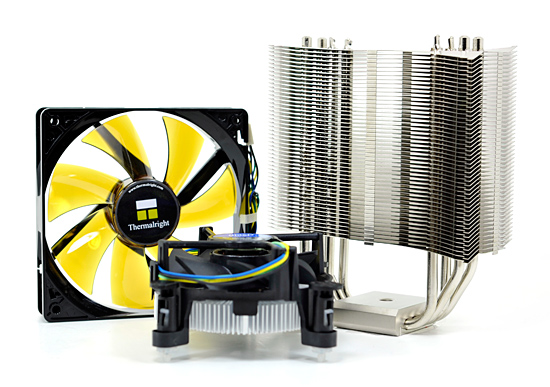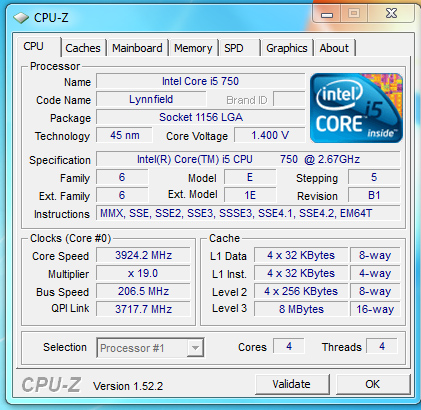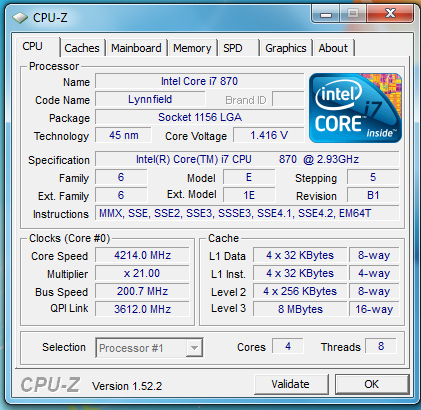Intel's Core i7 870 & i5 750, Lynnfield: Harder, Better, Faster Stronger
by Anand Lal Shimpi on September 8, 2009 12:00 AM EST- Posted in
- CPUs
Overclocking: Great When Overvolted, Otherwise...
Back when I asked Intel why anyone would opt for LGA-1366 over LGA-1156 one of the responses I got was: overclocking. The most overclockable CPUs will be LGA-1366 chips.
We tried overclocking three different CPUs: the Core i7 870, Core i7 860 and Core i5 750. We overclocked using two different coolers: the retail low profile HSF and a Thermalright MUX-120 (the heatsink Intel is sending around to reviewers for high performance testing). I'll get one thing out of the way: the retail heatsink pretty much sucks for overclocking:
| Intel Core i7 870 | Max Overclock (Turbo Disabled) |
| Intel Retail LGA-1156 Cooler | 3.52GHz (160MHz x 22.0) |
| Thermalright MUX-120 | 4.20GHz (200MHz x 21.0) |
The Thermalright enables higher overclocks by removing heat quickly enough allowing us to increase the voltage to the CPU. While roughly 1.35V is the limit for the retail cooler, The Thermalright MUX-120 let us go up to 1.40V. In both cases you need to have a well ventilated case.

Um, yeah.
Now for the actual overclocking results. We overclocked in two ways: 1) with turbo mode enabled and ensuring stability at all turbo frequencies (both single and multiple cores active), and 2) with turbo mode disabled simply going for highest clock speed.
The results are in the table below:
| CPU | Stock Clock Speed | Max Overclock (Turbo Enabled) | Max Overclock (Turbo Disabled) |
| Intel Core i7 870 | 2.93GHz | Default: 3.39GHz (154 x 22.0) 3C/4C Active: 3.70GHz | 4.20GHz (200 x 21.0) |
| Intel Core i7 860 | 2.80GHz | 3.23GHz (154 x 21.0) 3C/4C Active: 3.54GHz | 3.99GHz (210 x 19.0) |
| Intel Core i5 750 | 2.66GHz | 3.2GHz (160 x 20.0) 3C/4C Active: 3.96GHz | 3.92GHz (206.5 x 19) |
For best performance with all four cores active, disabling turbo mode is the way to go. Otherwise you have to reduce the BCLK in order to make sure your system is still stable when the one-active-core turbo mode kicks in. For example, with our Core i7 870 with turbo disabled we hit 4.2GHz using a 200MHz BCLK. If we used the same BCLK but left turbo enabled, when only one core was active we'd hit 5.4GHz - clearly not realistic with only air cooling.
The benefit of leaving turbo enabled is that you get a more balanced system that's not always using more power than it needs to.

The Core i5 750

Our Core i7 860 sample wasn't that great of an overclocker

Breaking 4.2GHz with our Core i7 870
At roughly 4GHz overclocks for all of these CPUs, it's reasonable to say that they are good overclockers. But how about with no additional voltage and the retail heatsink?
| CPU | Stock Clock Speed | Max Overclock, Turbo Disabled (No Additional Voltage) |
| Intel Core i7 870 | 2.93GHz | 3.37GHz (22 x 153MHz) |
The stock overclocks just plain suck on Lynnfield, you need added voltage to overclock the chip. With more voltage it works just like a Bloomfield or Phenom II, but at stock voltages Lynnfield just doesn't clock very high. And it has nothing to do with yields.










343 Comments
View All Comments
7Enigma - Wednesday, September 9, 2009 - link
"What you are doing is cheating, and people is not stupid."Hand meet Face..... Gentleman we have a winner! Could you please post a picture of yourself so I can make a T-shirt?
james jwb - Tuesday, September 8, 2009 - link
i wouldn't go that far at all, but look a few comments above for my feelings on this. The honest way to go about this, Anand, was to do this review as you have done, but have a page or two dedicated to clock for clock, and to state in bold letter that turbo mode was on for the benches in the current review. Do this and all is forgivenHave you stopped to think how well Turbo mode in Lynfield has boosted benchmarks compared to bloomsfield?
As i said, yep, nice feature, but i do not expect a site to fall for stuff like this, i'd do stock (turbo-crap) results like you have, because this feature is there and cannot just be ignored, but my interest would have been to present clock for clock results on other pages, and it should have been yours as well. You've done a disservice to the enthusiast here. I was loving Lynnfield in your review until i realised turbo was on, then i felt this review was 100% useless to what i care and want to know about - clock for clock, and it must be the same for a huge percent of your readers, who at this stage, some probably haven't even realized turbo was on in your results and are still salivating. All enthusiasts who like to overclock themselves and not have turbo trying to trick us in reviews want clock for clock, you left them out, that is serious cause for questioning what the hell is going on at Anandtech. Sure, for those here who run stock, the review suffices, but, well, i've made my point now i think...
This is the first real blunder i've seen on this site, but imo its a big one, and that blogger who hates you guys and posts up lots of stuff about your contradictions (to which so far i find all his posts false, the server blog guy, you know who i mean), today he'll have a field day on this one.
Anand Lal Shimpi - Wednesday, September 9, 2009 - link
I can add a disclosure saying that turbo mode was enabled, but this has always been the case for our Nehalem reviews. We always try to review products with all of their features enabled as long as they ship that way and they don't reduce quality (e.g. certain GPU driver optimizations in the past).While I'll gladly add a clock for clock against Bloomfield in a few tests, flip back to our Lynnfield preview if you want a preview of that (that chip could only turbo up by 1 multiplier - effectively making it a clock-for-clock comparison to Bloomfield).
Turbo mode in Lynnfield does help it against Bloomfield in the lighter threaded apps, do keep in mind that Bloomfield has turbo as well.
It seems like what you're saying is that you want the maximum overclock possible for all cores and as such you will definitely disable turbo mode. In that configuration, the only difference between Lynnfield and Bloomfield (from a purely CPU standpoint) is one channel of memory. As I've mentioned before, that one memory channel is not going to make a tremendous difference for the vast majority of users. But if this is what you're asking for, I can definitely provide it. I'm out in California this week for an unrelated product, let me get back and I'll include that data in my Core i7 860 review.
Take care,
Anand
james jwb - Wednesday, September 9, 2009 - link
thanks for the response, it's appreciated. I hold anandtech on a pedestal, and was just surprised not to see some clock for clock stuff for the overclockers out there. I haven't used a CPU at stock for 6+ years for my main rig, so clock for clock is very important, though as you've said, there won't be too much difference between bloomsfield and lynnfield, i'd still like to see it, though :)As for your comment below about how intel and amd will be changing things soon for the stock users out there, well, i think clock for clock will become very important for overclocker then in these reviews, more so than ever to find out how each cpu performs, or maybe i'm wrong!
ClownPuncher - Tuesday, September 8, 2009 - link
Why would they turn off a product feature when reviewing said product? Because PhII doesn't have it? That is like not including DX10.1 results for AMD in HAWX. Consumers usually buy products based on features, this product has an aggressive turbo boost.Gary Key - Tuesday, September 8, 2009 - link
"there you go, finally you said it.all the benchmarks have at least 600 mhz over the processor's stock speed.
that is outrageous, then if you want to compare the result with phenom 2 you have to overclock phenom 2 at least 600 mhz over stock speed.
just to be fair "
First off, it is fair as that is how Intel ships the CPU, turbo is an integral part of the CPU's operation and is a major feature, end of subject.
Second, the 965 BE is not going to run stable at 4GHz under a 64-bit OS without near or sub-zero cooling. The Phenom IIs continue to have a problem when approaching 4GHz with a 64-bit OS. AMD has not fixed it yet.
james jwb - Tuesday, September 8, 2009 - link
Sorry, but i disagree. You seem to have swallowed some genious Intel marketing crap here. Yes, it's a nice feature, but any CPU can overclock, all overclockers will overclock, and your results gloss over that benchmarks were using turbo. This is bad, and the first time i've really seen this site do something really biased, or just stupid, not sure which...I'm telling you now, a big percentage of your readers will see the results for the 920 and 750 as clock for clock comparisons and think its a very close game here, and it's not.
I'll forgive you once you do a clock for clock comparison, but i won't forget that you pushed turbo results and nothing else, and didn't put a warning big bold statements like you normally do for important info stating these are with turbo on. Watch all excitement for this review from overclockers dwindle if you do.
goinginstyle - Tuesday, September 8, 2009 - link
They had an entire section discussing turbo mode, comments were made in the results about the turbo advantage,and their system setup page clearly states turbo in turned on for both lynnfield and bloomfield. Read the article.james jwb - Tuesday, September 8, 2009 - link
the look at turbo is rubbish, we need clock for clock against bloomsfield.It's not in bold, its of that importance to state this for those who flick through, which you'll find many do.
And still, i have no gripe with the data presented so far (aside from it not being very, very clear that turbo was on), my problem is what has been left out, and that is - a lot of important stuff for the enthusiast who control his own overclock.
goinginstyle - Wednesday, September 9, 2009 - link
Look on page 9 under the system setup, it clearly states that turbo is enabled. It is mentioned several times in regards to the performance results. If you could read, you would have understood that TURBO was ON. Several pages of the article discussed the new Turbo mode and how important it is to the performance of the processor.I suppose because you have labeled yourself an enthusiast that means you should be treated special. I guess between you, SnakeOil, TA152H, and a couple of others we could hold a special Olympics in your honor. Wouldn't that be special?
What is amazing, is that after reading several other reviews, it appears only Snakeoil at Tech Report is posting the same crap there as he did here. Everyone used Turbo mode in testing so why are you not posting at the other sites about how mistreated you are as an enthusiast.
Probably around 98% of computer owners do not overclock so why is it so hard to understand the testing methodology used here and elsewhere. For those of us that do not overclock, this article was perfectly suited for us and shows that we can get similar performance without opening up the box. Even for those who do overclock, they at least showed clock results and I am sure we will see more based on Anand's comments this morning.